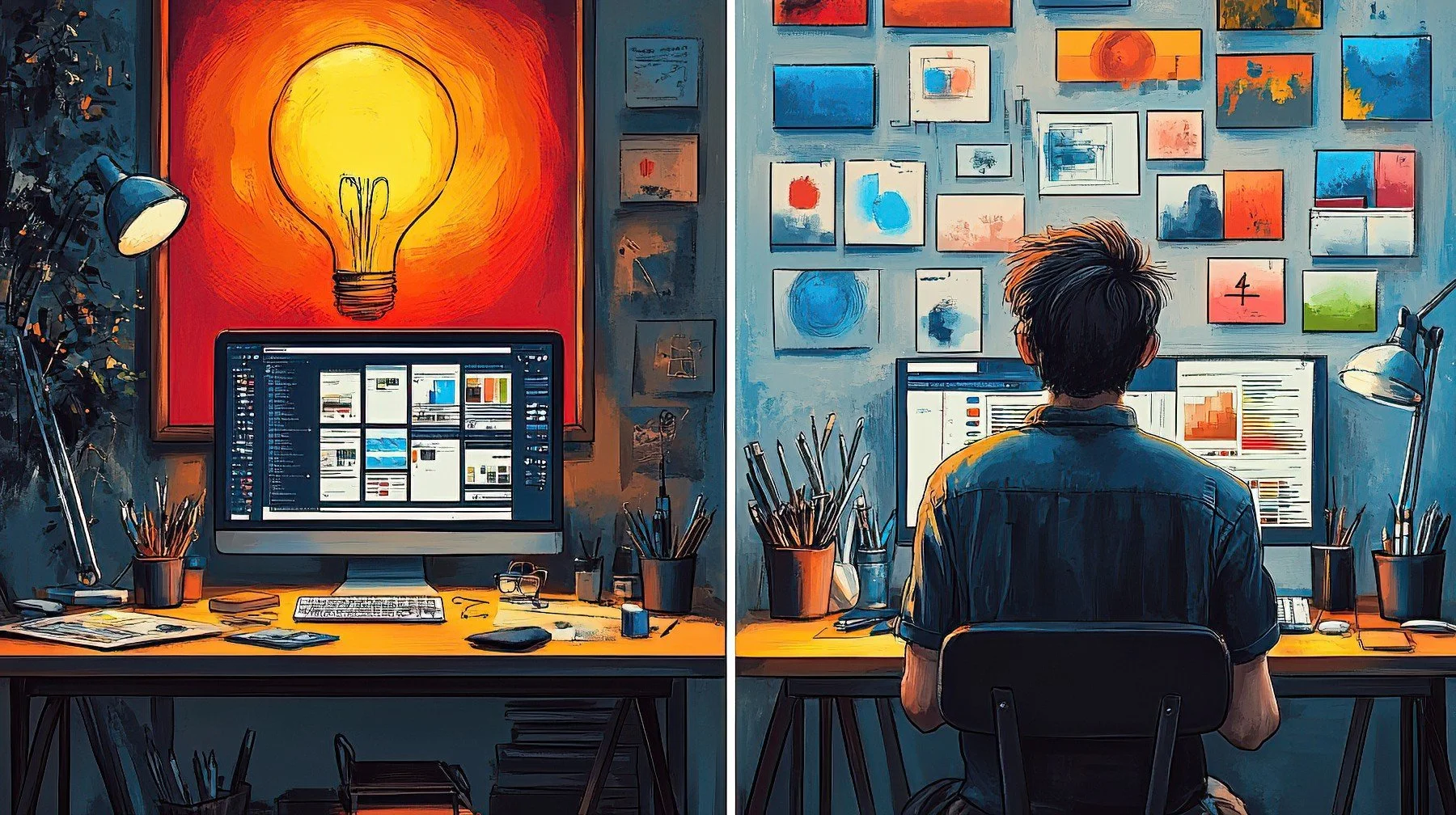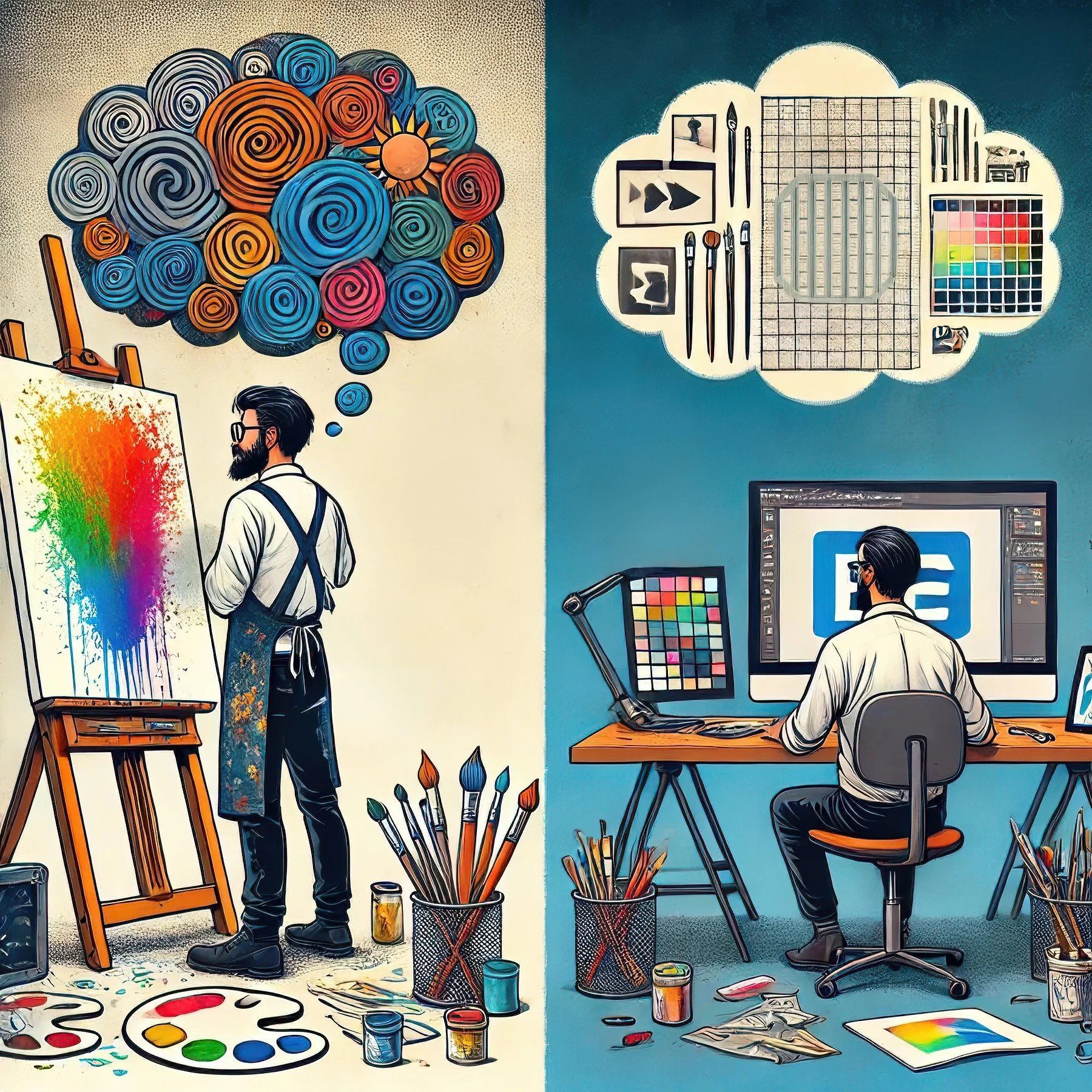All Graphic Designers Are Artists, but Not All Artists Are Graphic Designers
Let’s get this straight: all graphic designers are artists, but not all artists are graphic designers. It’s a bit like how all squares are rectangles, but not all rectangles are squares—except in this case, we’re talking about Adobe Illustrator and paint-splattered overalls. Confused? Stick with me, and I’ll clear it up in the most entertaining (and educational) way possible. You may even laugh once or twice. Maybe.
Art vs. Design: A Battle as Old as Time (or at Least Photoshop)
Artists are those mystical creatures who create from the depths of their souls. They pour raw emotion onto a canvas, make sculptures that say, “I’m deeply profound,” or sometimes just scribble something abstract that makes us nod and pretend we "get it." Their job is to express something personal, something subjective—maybe it’s an existential crisis, or maybe it’s just their cat doing something weird.
Now, graphic designers, on the other hand, are those cool, sleek professionals who can take that same cat, throw it into a logo, and convince you to buy an organic cat food subscription service. Graphic design is art with a brief. It's about communication, not just self-expression. Graphic designers live in a world where “does it look good?” is always followed by “does it work?” That beautiful font? It better be readable. That eye-catching color scheme? It should evoke emotion but also not cause seizures (thanks, neon pink).
Graphic Design is purpose driven while Art can be the purpose onto itself. The latter need not solve a problem but can potentially highlight one. Design as the word suggest is a process. It exists to solve a problem often with the purpose of compelling an audience toward an action often with the consequence of profit. Art can do that too right? Well it can but without the multi level complexities of marketing, visual communication and brand strategy as a whole. Art carries that unbridled freedom of expression of ideas, emotions and thought. Whereas with graphic design, all that expression has to be directed, reigned in and focused toward a very specific purpose rather than existing for the sake of existing.
Design is often mired in technical challenges that art for the most part need not pay heed to. One need not explain why painting pictures of butterflies and mermaids make them feel. An artists simply felt overcome by a certain inspiration and that is where the canvas and brush steered them. Whereas a graphic designer had better be designing with butterflies and mermaids if they’re trying to sell a bubble bath product line scented like flowers and need the visuals to convey the theme and feature characteristics of the product. It also had better justify the price tag and result in sales and/or communicate a message. Sensing the difference yet? Read on.
The Functional Side of Creativity
While artists can paint a canvas and let the world interpret whether it's a commentary on capitalism or just a really nice shade of blue, graphic designers are in the business of getting the message across loud and clear. Designers make the visual world digestible for people who need information but are too busy scrolling Instagram to read a block of text. “Less is more,” said every minimalist graphic designer ever (and probably Ludwig Mies van der Rohe) .
In graphic design, the message is king, and the visuals are its loyal, pixel-perfect subjects. Designers must balance aesthetics with functionality. Imagine a website that’s gorgeous but impossible to navigate—like trying to get out of an Ikea. Sure, the art's pretty, but it’s a disaster for anyone who’s just trying to get to the kitchen section. Graphic designers ensure that beauty and usability get along like peanut butter and jelly—well, except for that one time they tried to use Comic Sans. Yikes! Enough already.
No One Wants a Marketing Picasso.
Take in another example where an artists was hired to create a logo for a business. The result was an incredible and awe-inspiring work of visual mastery depicted angels and unicorns is a splendid cacophony of aesthetic harmony. But absolutely no one told the artist that such a logo had absolutely nothing to do with a fitness studio it was to represent; nothing at all and so it resulted in a massive fail.
It would stand to reason that someone hiring a designer or artist would no the difference but the distinction isn’t as clear with the unlearned. Often has it been witnessed that simply because a cousin’s daughter best friend’s baby sister is a anime drawing savant. Someone convinced her she would make a great graphic designer. Not so fast! That’s not how it works. In fact, statistically most artisst that try for such a career ends up bowing out pretty soon after starting. They consider design too strict and rigid. Look, a painters got to paint right? They can’t be bogged down with brand standards and guidelines. They don’t care about board meetings and omni-channel marketing strategy. Hey, let them paint fields of tulips all they want to. Tulips have never hurt anyone. But painting fields of tulips won’t sell a single transmission for a tractor.
Why This Matters: No One Wants a Marketing Picasso
So, why does this distinction even matter? For starters, if you’re a business hiring someone to create your brand identity, you probably don’t want the next Picasso. Sure, it might be “abstract” and “open to interpretation,” but that’s not super helpful when all you wanted was a clear, readable logo for your organic dog biscuit brand.
Graphic designers don’t just make things look good—they make things work. An artist might draw you something that belongs in a museum, but a graphic designer will give you a logo, website, or social media campaign that belongs in your customers' wallets.
According to legendary designer Paul Rand, “Design is the silent ambassador of your brand”. Essentially, graphic design is like that cool, collected spokesperson you didn’t know you needed, communicating your brand message even when you’re busy at brunch. Art, on the other hand, might just sit there on the wall, silently judging your inability to comprehend its meaning. It’s in no way less than. It just serves a different purpose which may or may not have anything to do with graphic design and it may never.
How does education play into this?
There is something to be said of graphic designers coming fresh off the school bus and wanting to run straight into the corporate world and land that first big gig. Or your super talented niece who can paint like Picasso with her eyes closed. They’re often given a twisted perception of what graphic design is like. They believe and are taught, that they are so talented that the talent itself is all they need. Yet, to be successful at all in the highly competitive field of graphic design one must be willing to learn other aspects of the field and be ready for some very harsh criticism. Told to me by some students, “I wasn’t taught how to be a critical thinker or think about marketing and communications. I was just taught how to use the software.” What???!!!! Yeah. Unfortunately, that is fairly common nowadays.
How else is an artist not automatically a graphic designer? Well be prepared to almost never create what you want to. You and your talents as a graphic designer is a tool and more often than not, you’ll be given your narrowly defined marching orders to go make this often bad idea (whatever it may be) look great. By the way, you can only use these two colors. It can only be this tall. It can only in vector but also be able to be converted to an image if need be. Be prepared to have what was once your baby, your vision, your masterpiece bastardized into something you never envisioned. By the time it is done, it’s not even your design anymore. Guess what fancy pants. It never was yours to begin with. You produce art for a living and for a very specific other defined purpose often not your own. Forty different perspectives had to be accommodated and the design now looks like a thousand blindfolded people each had an idea and you had to stitch it all together into a Frankenstein-ish rendition of… well something. That is an artist but not the way your average Joe thinks of an artist am I right?
That is often where education fails graphic design and art students that want to be designers. You can’t just go learn Photoshop and Illustrator, take a couple of classes and hit the ground killing it no matter how good you were in your sculpting class or color theory class. No youngling. It’s brutal, competitive and full of ups and downs. It sounds like a war movie but it’s just a day of graphic design and then you have to do this all over again tomorrow. Still think it sounds like regular art. You’d probably rather be someplace painting those watercolor butterflies in pastel tones just for kicks and giggles and if you’re lucky, sell a few of them if you chose to.
Essentially, graphic design is like that cool, collected spokesperson you didn’t know you needed, communicating a brand message even when you’re busy at brunch. Art, on the other hand, might just sit there on the wall, silently judging your inability to comprehend its meaning. It’s in no way less than. It just serves a different purpose which may or may not have anything to do with graphic design and it may never. Yet, they are both beautiful, rewarding avenues of expression but not at all alike.
On a more personal note, one might say I tend towards graphic design or more specifically, marketing and visual Communications via Directing and Project Management. Why? I strive towards structure and bringing order to the chaos that pure art can sometimes manifest. Omni-channel marketing, business development, technical writing, computer systems, programming, spreadsheets, data analytics and management appeals to me as much as art, graphic design, videography, content production and publishing does. This is as they say… “My Jam.” Creative Director or graphic design by extension is how it all comes together to employ the different facets of my skillset. It is being underutilized that is so disturbing for me so art for art sake is very much apart of my repertoire but it cannot be the only part.
The Conclusion: Different, but Equal (Well, Sort of)
In the end, both artists and graphic designers are vital. They’re just playing on different fields—artists in the wild, rule-free jungles of expression, and graphic designers in the fast-paced, client-driven, caffeine-fueled world of communication.
So, next time you see someone hunched over their Wacom tablet or clutching a paintbrush like their life depends on it, remember: one may be crafting the next great social media campaign, and the other may be deciding whether a blue dot is enough to symbolize the human condition. Both are important, but only one can help you sell that artisanal kombucha. And that, my friends, is why all graphic designers are artists, but not all artists are graphic designers and don’t even get me started on sculptors. They are artists but they are certainly not graphic designers.
References:
Ludwig Mies van der Rohe, "Less is More" (Architecture's Greatest Hits, circa 1950s).
Designers Against Comic Sans, "Why We Can’t Have Nice Fonts" (2005).
Paul Rand, "Design is the Silent Ambassador of Your Brand" (Legendary Designer’s Guide to Awesome Branding).

